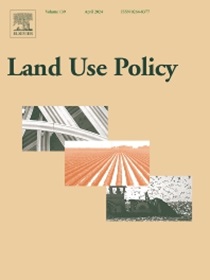南非东开普省和夸祖鲁-纳塔尔省村庄耕地放弃的复杂和相互作用驱动因素
IF 5.9
1区 社会学
Q1 ENVIRONMENTAL STUDIES
引用次数: 0
摘要
自20世纪以来,全球有大量农业用地被遗弃。虽然对农业用地放弃的驱动因素进行了广泛的研究,但不同区域的模式各不相同,因此需要对具体地点进行研究,以协助发现更广泛的模式。本文评估了社会经济和环境因素如何影响四个村庄的小农放弃田间种植的决定,其中两个在东开普省,两个在夸祖鲁-纳塔尔省。使用半结构化问卷收集数据,对四个村庄的家庭进行调查:Gotyibeni (39), Manqorholweni (30), Mawane(41)和Melani(58),共计168个。使用ArcGIS Pro随机选择住户。每个人都有耕地,大多数在4到5 公顷之间。然而,四分之三的人弃田的平均时间为19年,其中大多数弃田发生在11-30年前。结果表明,以女性为户主的农户耕作参与率较低。非种植家庭中55岁以上个人的比例较高(51% %)。种植需要租用拖拉机,购买种子和化肥,受访者认为由于田地面积大,成本高昂。被提及最多的限制是围栏,这与更广泛的财政限制联系在一起。这些财政挑战与严重依赖社会补助金有关,而社会补助金本身又与教育水平低和就业机会有限有关。其他障碍包括动物破坏作物、农民年老以及距离田地太远。这些因素跨越社会、经济和环境领域,但又相互联系。该研究建议采取政策干预措施,如有针对性的农民支持、青年参与农业、更好地获得土地、重振部落当局的作用以及促进气候智能型农业。本文章由计算机程序翻译,如有差异,请以英文原文为准。
Complex and interacting drivers of arable field abandonment in villages of the Eastern Cape and KwaZulu-Natal, South Africa
Significant areas of agricultural land have been abandoned globally since the 20th century. Although extensive research exists on the drivers of agricultural land abandonment, patterns vary across regions, necessitating site-specific studies to assist in the detection of broader-scale patterns. This paper evaluates how socio-economic and environmental factors influenced decisions of small-scale farmers to abandon field cultivation in four villages, two in the Eastern Cape and two in KwaZulu-Natal provinces. Data was collected using semi-structured questionnaires administered to households in four villages: Gotyibeni (39), Manqorholweni (30), Mawane (41), and Melani (58), totalling 168. Households were randomly selected using ArcGIS Pro. Each had access to arable fields, most between 4 and 5 ha. However, three-quarters had abandoned their fields for an average of 19 years, with most abandonment occurring 11–30 years ago. Results show that female-headed households are less involved in cultivation. Non-cropping households had a higher proportion of individuals over 55 (51 %). Cultivation required hiring tractors and purchasing seeds and fertilisers, which respondents found costly due to large field sizes. The most cited constraint was fencing, which tied into broader financial limitations. These financial challenges were linked to heavy reliance on social grants, itself related to low education levels and limited employment opportunities. Other barriers included crop damage by animals, aging farmers, and distance to fields. These factors span social, economic, and environmental domains but are interlinked. The study recommends policy interventions such as targeted farmer support, youth involvement in agriculture, better land access, revitalised tribal authority roles, and promotion of climate-smart agriculture.
求助全文
通过发布文献求助,成功后即可免费获取论文全文。
去求助
来源期刊

Land Use Policy
ENVIRONMENTAL STUDIES-
CiteScore
13.70
自引率
8.50%
发文量
553
期刊介绍:
Land Use Policy is an international and interdisciplinary journal concerned with the social, economic, political, legal, physical and planning aspects of urban and rural land use.
Land Use Policy examines issues in geography, agriculture, forestry, irrigation, environmental conservation, housing, urban development and transport in both developed and developing countries through major refereed articles and shorter viewpoint pieces.
 求助内容:
求助内容: 应助结果提醒方式:
应助结果提醒方式:


